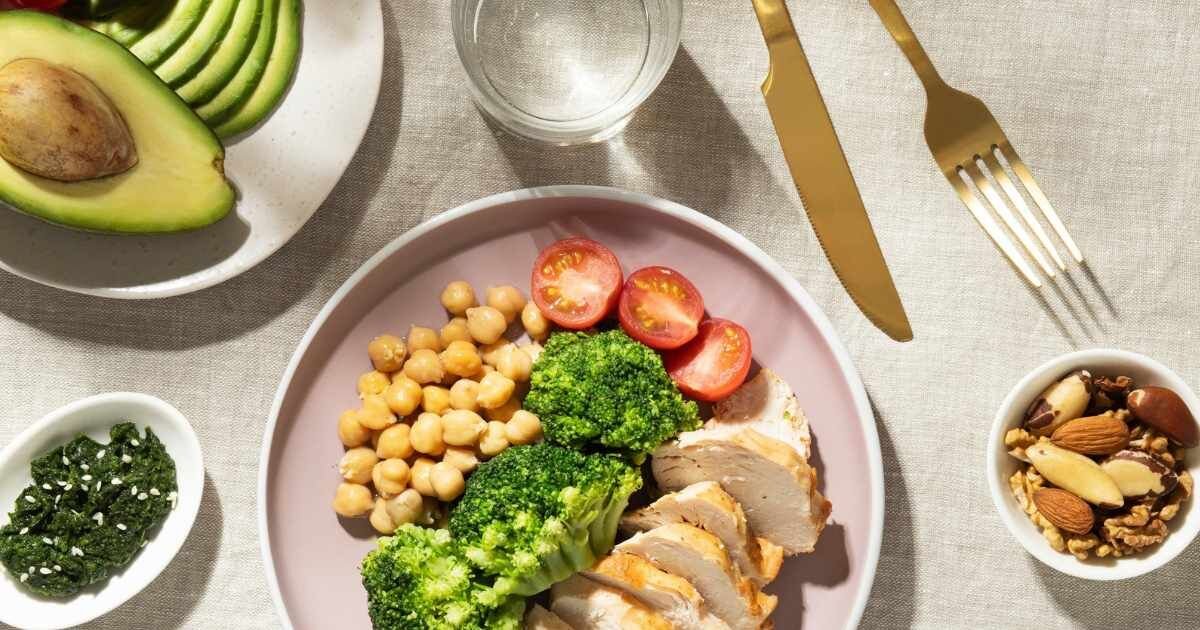Blog
No Time to Cook? Nutrition Tips for a Busy Lifestyle

The modern age makes for busy lifestyles, meaning choosing a nutritious diet can be more difficult than you’d hope. However, there are small changes you can make in your daily life to make healthy eating easier.
Eating healthy is more than just the foods you choose – it’s about sustainably integrating them into your lifestyle. This can be a challenge. Most Canadians have difficulty understanding the per cent daily value and the different units (such as grams, milliliters, and percentages) commonly found on food nutrition labels.
Not only this, but there’s a wealth of information out there, which can make finding the right approach difficult. But fear not, Cook’s Pharmacy will give you some simple nutrition tips for a busy lifestyle.
If Meal Prepping is Too Much, Prepare Ingredients Instead
We understand your days are unpredictable, so trying to prepare a batch of the same repetitive meals may not be your first choice. The worst thing is preparing a bunch of food only to find that it isn’t what you want to eat on that given day. Meal prepping may be daunting when you’re just getting started, but that’s OK; there’s an alternative approach.
Rather than preparing individual meals, prepare healthy meal components in medium to large batches– such as vegetables, carbohydrates, and even proteins. This way, you have the components of a meal prepared and you can build your desired plate based on what you have ready. If you want to add something new, you only have one or two additional components to prepare.
If you have a batch of green beans and wild rice ready, all you have to do is cook a single piece of salmon – or maybe throw in yesterday’s leftover steak and sauce on top. Easy, simple, healthy. No fuss, little mess, and you have no reason not to have a nice nutritious meal.
This isn’t just effective with meals – it’s great to have healthy snacks prepared, too. You can pre-boil hardboiled eggs, chop fresh fruits and veggies, and portion out dips such as hummus or tzatziki. This stops you from going to that corner store to buy a candy bar or bag of chips (although these are OK in moderation) because you have tasty and easy snacks on hand whenever you get a bit peckish.
Food prep doesn’t have to be an arduous task. Having simple, healthy ingredients at the ready can be done in an hour or less a week. Saving you time and making nutritious eating easier.
Eat More Whole, Unprocessed Foods (The Smart Way)
It’s OK not to eat perfectly, but if you find it challenging to consume more nutritious food, the easiest stepping stone to a healthier lifestyle is choosing more whole foods.
Whole foods refer to foods that are in their natural state and are generally minimally processed. This includes meat, fish, protein, beans and legumes, gourds, eggs, and more.
However, it’s important to remember that not all food processing is bad – when we refer to ‘processed foods’, we’re typically talking about ultra-processed, convenience foods. Think of hot pockets, microwave TV dinners, and fast foods, for example.
While almost all foods can be a part of a healthy diet, eating a diet consisting of mostly whole foods is linked to overall better health. 46% of Canadians’ daily energy consumption (2015 study) came from ultra-processed foods, with children and youth being the biggest consumers. You can see more recent studies here.

Generally, if you eat more whole foods, you’re likely to get more nutrients and feel fuller, for longer. Here are some additional key benefits:
Nutrient-rich
Minimal processing
Better digestion
Weight management
Reduced risk of chronic diseases
Better mood and mental health
If you find it overwhelming to eat only whole foods, try to build tangible meals that include SOME convenience foods, but opt for better accoutrements or choose better options for more balanced nutrition.
Instead of having deep-fried chicken nuggets, fries, and a Coke – choose an air-fried turkey nugget, and serve it with a side of broccoli and roasted sweet potato. Then, for a beverage, try opting for zero-calorie, flavoured sparkling water.
Or, instead of ordering a large pizza, make a whole-wheat, pita pizza at home with better ingredients like low-fat cheese, sliced chicken, lots of veggies, and a low-sodium pizza sauce. You can serve this with a homemade garden salad and a beverage. Here are some additional drink options if you struggle to find alternatives to soda or sweetened juices:

Infused water (with fruits, herbs, or cucumber)
Herbal tea (iced or hot)
Coconut water
Sparkling water
Freshly squeezed fruit juice (without added sugar)
Lemon or lime water
Green tea (iced or hot)
Kombucha
Vegetable juice (like carrot or beet juice)
Almond milk or other plant-based milk
Eat More Protein (The Easy Way)
Protein isn’t just for bodybuilders – protein is an essential nutrient for physical recovery, appetite, and weight management. This is particularly important to consume as you age.
In simpler terms: eating protein helps to keep you full and satiated. When we overeat, we generally opt for foods that aren’t quick to trigger your fullness cues. According to Harvard Health, ultra-processed foods are linked to overeating and weight gain. That’s why you might find yourself still feeling hungry, even after eating a bag of chips or a chocolate bar.
By consuming meals that are high in protein and rich in fiber, you’re far less likely to be hungry after eating. If you do find yourself prone to overconsuming food, even after a meal, try to wait 20 minutes after a meal to allow your natural fullness signals to kick in. Also, try to eat slower and fully enjoy your meal, ideally, without any distractions such as phones or TV.
If you have trouble getting protein in due to time, make sure protein-ready meals and snacks are accessible. Start your morning off with a protein shake; pack a high-protein Greek yogurt in your lunch; make sure you have hardboiled eggs; cut up some cold tofu and toss it in a pre-packaged salad. There are lots of easy high-protein snacks to choose from:
Cottage cheese
Edamame
Hummus with veggies or whole grain crackers
Turkey or chicken slices
Protein bars (low sugar)
Roasted chickpeas
String cheese or cheese slices
Tuna or salmon (canned or in pouch)
Peanut or almond butter (with apple or celery)
Track Your Calories (The Modern Way)
We couldn’t talk about nutrition tips for a busy lifestyle without touching on calorie intake.
While this doesn’t need to be a life-long pursuit, learning to track your calorie intake provides you with tangible data to understand how much you’re eating. Many Canadians have little to no concept of their calorie intake, which can make maintaining, losing, or even gaining weight difficult.
By tracking your calories, you can get an idea of how much you’re eating and determine a good daily intake of calories to meet your health goals. However, make sure you speak with a healthcare provider and a nutritionist before you embark on any serious diet changes. You need to ensure you maintain balanced nutrition, so seeking professional advice is important.
How do you track calories properly with a busy lifestyle?
You can use a variety of apps to log calories, but the truest, best way to track calories is to weigh food with a food scale. You weigh the food, find the food in an app, such as MyNetDiary (this app is free to use), and input the portion based on grams, milliliters, etc. For example, according to MyNetDiary, 100 grams of boneless, skinless, baked chicken breast comes to approximately 187 calories and consists of 33 grams of protein, 1 gram of carbs, and 5 grams of fat.
That’s a breakdown of 75 per cent protein, 1 per cent carbs, and 24 per cent fat.
You may be wondering – how do I track calories when I barely have time to cook? Luckily, most diet tracking apps allow you to log full meals and save them to a library - allowing you to quickly add them to your daily intake. No fuss is required.
Say you save a meal of baked chicken, broccoli, and wild rice with lemon sauce into your tracking app. Provided your meals are generally consistent, you can quickly add these to your daily intake. A meal like that could be around 550 calories, approximately.
DISCLAIMER: The majority of apps (including the one above) do not advise that anyone who has a history of eating disorders, or who actively struggles with eating disorders, use their applications. Tracking calories is generally not recommended for those with histories or current struggles with eating disorders. If you or anyone you know is struggling with an eating disorder, see NEDIC.ca for resources.
Also, it’s important to know that tracking calories isn’t only intended for weight loss. The purpose of tracking calories is very individual, and can be linked to several motivations and goals:
Understand daily calorie needs
Maintain or achieve a healthy weight
Monitor macronutrient intake (carbs, protein, fat)
Ensure balanced nutrition
Identify overeating or under-eating patterns
Increase awareness of portion sizes
Track the nutrient density of foods
Make informed food choices
Support fitness goals (e.g., muscle gain, fat loss)
Stay consistent with a specific diet plan
Manage specific health conditions (e.g., diabetes)
Develop healthier eating habits
Choose Cook’s Pharmacy Today
At Cook’s Pharmacy, we deeply care about you and your health. As an independent pharmacy, we remember your name and your unique circumstances and work with you to find the health solutions to best serve you. If you’re struggling with nutrition or any other possible ailments, contact us today.
Contributors
Latest Posts
Show All Recent Posts
Archive
-
2025
-
2024
-
December
-
November
-
October
-
September
-
August
-
July
-
June
-
May
-
April
-
March
-
February
-
January
-
-
2023
-
December
-
November
-
October
-
September
-
August
-
May
-
April
-
March
-
February
-
January
-
-
2022
-
December
-
November
-
October
-
September
-
August
-
July
-
June
-
May
-
April
-
February
-
